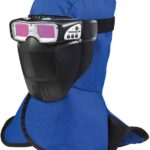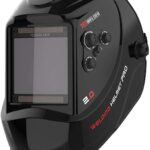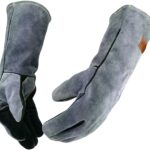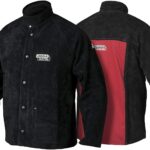The concept of underwater welding is quite interesting. And if you are looking for detailed information about the process then, you have landed on the right page.
Do you know about hyperbaric welding? Well, if we perform a hyperbaric welding process in the wet surrounding or a wet environment then, it is referred to as underwater welding. A lot of people often confuse with the words underwater welding and hyperbaric welding. A hyperbaric welding process can be called underwater welding if and only if it is carried out in an environment where water is present.
Underwater welding is known to human beings since 1930. It is widely used for maintaining the marine infrastructure that is present underwater.
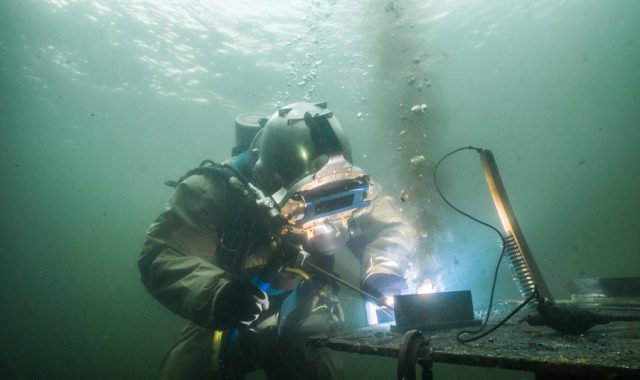
Types of Underwater Welding
It is classified into two types:
- Wet Underwater Welding (WUW)
- Dry Underwater Welding (DUW)
1. Wet Under Water Welding
It is evident that welders mostly use Shielded Metal Arc Welding (SMAW) as it is the most effective and affordable welding method. Shielded Metal Arc Welding is also called Stick Welding. With the help of the Stick Welding, an electric arc is generated between the electrode and the base metal. In most cases, the base metal is often copper or aluminium.
In the wet underwater welding process (WUW), drivers have to be very attentive and they must follow various certain rules. Here, the most important thing that the welder should do is keep the electrode very clean.
Usually, when the welders are ready, they alert their respective teams to pass the current when the electrode is in touch with the base metal.
Which type of current is used during wet welding? In the wet welding process, direct current is used. Direct current is very safer to use in underwater conditions than alternating current.
The wet underwater welding process takes place in the following manner:
- The work that has to be welded is attached at one end of the electric circuit while a metal electrode is attached at the other side.
- The electric arc is formed due to the supplied current. Then, bare metal is welded and the formation of a weld pool takes place.
- Due to the heat generation, the electrode melts and the projection of the metal droplets takes place into the projected area. At the same time, the flux which is coated on the electrode melts to form the shielding gas. This shielding gas is used for stabilizing the arc column.
Requirements of the wet underwater welding process:
- Power supply: 300 to 400 amps of current. Motor generators or DC generators.
- Gas manifolds
- Power converter
- Welding generator
- Power converter
Wet underwater welding uses two types of welding process:
1. Flux-Cored Arc Welding (FCAW): In the flux core arc welding, an electrode is used for welding of alloys made up of nickel and cast iron.
2. Friction Welding (FW): In friction welding, friction and heat are used for the melting of the metal.
Advantages of WUW
- Low cost: The most important benefit of wet underwater welding is that it is very affordable as compared to dry underwater welding. It is also versatile to carry out.
- Quick and Easy: The WUW process is easier to carry out. We can do it at a very faster rate with more effectiveness.
- Can Weld in the Complicated Areas: The key advantage of wet underwater welding is that it allows users to weld in the complicated offshore area. Another welding process cannot be carried out easily in the complex offshore structures.
- Minimum Equipment is Required: In wet underwater welding, minimum equipment is required. A standard welding machine and a few other machines are required in this process.
Disadvantages of Wet Underwater Welding:
- Less Strength: The strength of the weld formed in the wet underwater welding is very less. This is because of rapid quenching process. Fast quenching also affects ductility. In short, this welding affects the strength as well as the ductility.
- Low efficiency: As the entire process is done in the water. We have to face the situation of poor visibility. Due to poor visibility, we can’t do the welding efficiently.
Also Read:
- Explosive Welding – Equipment, Types, Working, Advantages and Disadvantages with Application
- What is Welding Defects – Types, Causes and Remedies?
- Top 8 Advantages of arc Welding
Dry Underwater Welding:
In the dry welding process, a special type of chamber is used as a welding environment. Here, the welding is done in the same way as that of the regular welding process. But, a seal-like structure is created around the area which is to be welded. A mixture of gases like helium and oxygen is present in such an area.
The dry welding is done under water, following four dry welding methods are used:
- Habitat Welding: In habitat welding, welders use a room-sized chamber having the same pressure outside it.
- Dry Spot Welding: Dry spot welding is usually performed for chambers that are smaller in size. Here the chamber size is as small as that of the head of the person. The welder has to insert the electrode inside the chamber
- Pressure Welding: In pressure welding, the pressure of 1 atmosphere is usually present.
- Dry Chamber Welding: In dry chamber welding, the size of the chamber is usually bigger than the size of it inside the dry spot welding.
Shielded metal arc welding (SMAW) is also used in dry underwater welding. Along with the shielded metal arc welding, the following welding process may be used sometimes:
1. Plasma Arc Welding: In plasma arc welding, an electric arc is used. Here, the intense heat generated due to the generated electric arc is used for welding aluminium, stainless steel and other types of materials.
2. Gas Tungsten Arc Welding: Gas tungsten arc welding is also named as GTAW. Sometimes welders also called it a TIG. In the GTAW, a non-consumable electrode is used. Most of the times this electrode is made up of tungsten. After the formation of the electric arc, heat is generated. Alloys of aluminium, stainless steel can be easily welded with the help of the GTAW process.
3. Gas Metal Arc Welding: Gas Metal Arc Welding is abbreviated as GMAW or it is also known as MIG welding. In Gas Metal Arc Welding, a shielding gas is used. A shielding gas passes through the welding gun. Shielding has helped in welding non-ferrous metals like aluminium.
Also Read:
- Difference Between MIG and TIG Welding
- Ultrasonic Welding Process – Working Principle, Parts, Advantages and Disadvantages with Application
- Laser Beam Welding – Equipment, Principle, Working with Advantages and Disadvantages
Advantages of Dry Underwater Welding:
- Safety of the welder:
The dry underwater welding is performed in the chamber in the dry condition. As water is not present in the chamber, the welder is in a safe condition. The dry area is well illuminated. Also, it has its own Environmental Control System (ECS).
That means, there are very fewer chances of danger to the welder while performing the dry underwater welding. Hence, dry underwater welding is beneficial and less hazardous.
- NDT: Non-Destructive Testing
Do you know about the NDT? NDT stands for non-destructive testing. We use the non-destructive testing method to know about the strength of the material. NDT can be easily carried out in the dry environment and after the dry underwater welding process.
- Excellent Quality Weld:
While doing welding, we always aim to get the best weld joint. The dry underwater welding process has a capability of producing high-quality weld joints as compared to the open-air weld joints. Can you guess the special reason behind the production of the quality weld due to the dry underwater welding?
- First of all, as the water is not present inside the chamber or during this process, weld doesn’t get quenched easily.
- The second reason is the less presence of hydrogen near the weld area.
During dry underwater welding (DUW), the surface can be monitored easily. That means we can usually inspect the joint, and alignment of the pipe without any hassle
Disadvantages of the Dry Underwater Welding:
- Complex Habitat:
Here, we use a chamber as a habitat. For building this chamber, a lot of complex things have to be done. Also, various precautions are must be taken for creating the entire habitat where we can do to the welding without any issue.
- Costlier Process:
The important drawback of the dry underwater welding is that this process requires a lot of money. For producing a single weld, we require $80000. This amount is very large. Also, a used chamber cannot be reused for doing welding at different locations inside the water.
Here, the cost of the process is directly proportional to the depth of the welding zone under the water. So, if you want to implement this welding at very high depth then, a large capital has to be invested.
- High Voltage Required:
At higher depths inside the water, constriction of the arc takes place. The more the constriction more is the voltage requirement.
- For producing large voltage, more equipment. Sometimes the process becomes impossible to conduct if the voltage requirement is too large.
Dangers of Underwater Welding:
Underwater welders are working with many variables like atmospheric pressure, water environment, different welding equipment, electric current and so, and many other things. The duty of the underwater welder is not that easy. They may have to face below dangers while doing their work:
- Hypothermia:
Hypothermia causes when individual work in the water conditions for many hours. This can be the most common problem in the underwater welders. If proper precautions are taken then, we can easily avoid hypothermia.
- Explosions:
We all know that explosions happen when hydrogen, current and oxygen gases mix in the large amount. So, underwater welders have to be very careful while dealing with the current in the large amount.
- Electrical shocks:
Do you know the reason behind the electric shocks?
Electric shocks are produced if an underwater welder is less experienced and he uses an alternating current for the welding purpose.
Alternating current can be very dangerous and give rise to intensive electric shocks if used inside the water for welding.
- Drowning:
Drowning is the most common hazard faced by underwater welders. Drowning results when a pressure difference is generated. Delta P hazards also cause it.
Precautions
Safety precautions that one must take during the underwater welding process:
- A welder which is doing the work under the water must be in contact with his teammates. More appropriately, he must contact his colleagues from time to time during the entire welding process.
- He or she must wear the required clothes. Clothes must be water-resistant.
- You must have another welder with you for assistance and help.
- One must take proper education of the underwater welding before involving in it.
There are various underwater welding programs are available which you can learn from. But it is advisable that you must learn the skill of underwater welding from the people who have gained mastery in that field.
The Impressive Salary of the Underwater Welders:
What do you think about the salary of the underwater welder? Well, an underwater welder can earn from $20,000 per year to $300,000 per year depending on his/her skill level. You may be thinking that’s a quite huge salary, right?
The salary of underwater welders is huge. But the risk involved in this job is also large. Another thing is that a lot of skill set is required to do this welding process without any issues. As the skilled requirement and risk involved are high, the salary of underwater welders is also big. If you are interested in underwater welding then, you can join respective courses to learn more about it.
Scope of the Underwater Welding:
Underwater welding has a very bright scope. Though humans knew this process for many decades, very fewer researches are done in this field. So, scientists are doing a lot of research and innovations in this field. This research is mainly about lowering the cost of this process and enhancing its efficiency.
The development of the driverless underwater welding machine is also a trending topic in this field. Researchers are also working hard on the electrodes that can be used for longer times in the complicated underwater areas. Overall, the underwater welding has a large scope and many innovations need to be done in this field.
Working of Underwater Welding
For a Better Understanding Watch the Video:
Thanks for reading this article. We hope that you got the required knowledge about underwater welding. If you like the post then don’t forget to like and share it.
